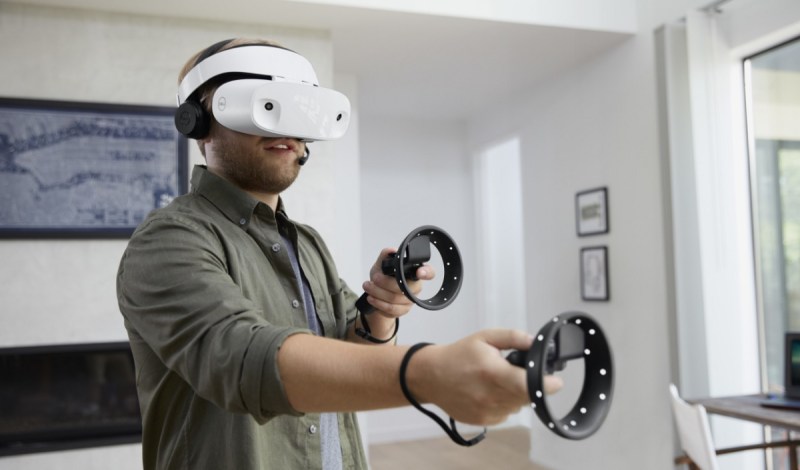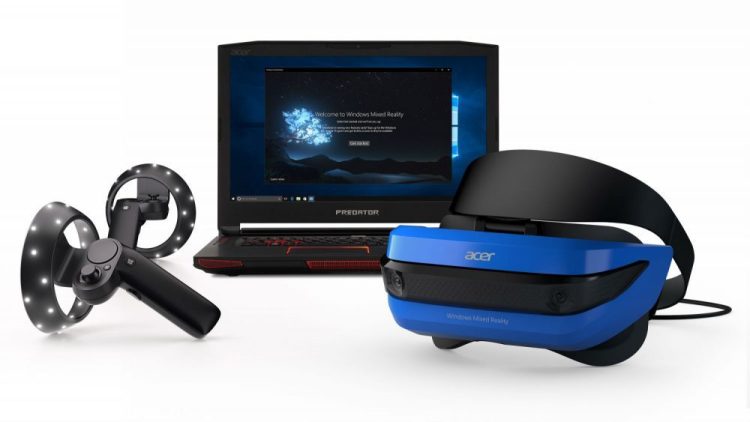
Above: Samsung’s Windows-based mixed reality headset.
Question: Where do you see Windows Mixed Reality working with phones?
Kipman: I don’t have anything more to share today on that topic. Today we’re here to talk about these headsets. I will say that at the end of the day, mixed reality does go from phones to PCs to headsets. If you closely track what we talk about, we talk about this idea of a Microsoft graph. The Microsoft graph is the ability we have to make sure we embrace the entire ecosystem, the plurality of devices out there. In this case, you could start browsing the web on your iPhone or Android phone and continue or finish that browsing on PC. Or you can start creating a Powerpoint on your PC and finish it on your iOS or Android or Windows phone.
It’s very easy to imagine a future, from a mixed reality perspective, where we’re going to continue to leverage this Microsoft graph we’re building to make sure that this value to our customers continues. I said it at the beginning: this thing is going to transcend time, space, and devices. I don’t know what you have in your pocket, but I’m going to bet it’s not a Windows phone. But what is the value that’s going to come to you from that experience? Let’s be people first. Let’s be customers first. With the Microsoft graph, you should expect that our experiences will start transcending devices.
I’m excited about the progress the entire industry has made toward embracing mixed reality this year. You guys have seen the developments on other platforms. I’m excited about it. It’s more sensors and more devices that will let the value of our AI-infused OS, of our mixed reality experiences, both in enterprise and in the consumer space, see value across the entire value chain.
Question: In your demo you showed both augmented reality and virtual reality, with the Samsung headset. Is the market breaking down already, in this early stage, where business use will be AR and consumer use will be VR?
Kipman: I really don’t think so. We’ve spoken before on this. That’s why we call it mixed reality. Without a shadow of a doubt, I can tell you that in the near future, devices will do both. What are we going to call those devices? As soon as I make a HoloLens go opaque, what is it? As soon as you pass through AR into virtual reality, what is it?
Most of the enterprises I talk to you, again, they’re using HoloLens for first-line worker scenarios — someone working on a jet engine, a manufacturing line, an oil refinery – but when they call a knowledge worker that’s sitting at a desk for help, for remote assistance or anything like that, more often than not that person just wants to put a VR headset on.
To some extent, what I think you’re seeing is that because the world has fragmented the platforms, enterprises have to pick. Consumers have to pick. Which is why we have, from the beginning in 2015, called this thing mixed reality and created a unified platform for both. As you give these gorgeous devices, with that same universal platform, to those same amazing enterprises and consumers, what you’re going to start seeing is you have the range to do both.
The real value comes in when you’re transporting people, places, and things in either a digital or analog fashion. These devices allow you to do that.

Above: HP’s VR headset and backpack with attached laptop.
Question: You showed the Cliff House and a lot of ideas around productivity, which I always find interesting – the idea of multitasking in those windows. I use these systems a bit already. But one I’ve problem I’ve seen—how do you solve or rectify the problem of keyboards?
Kipman: Maybe I’m biased because I work with these things, but I’m using them more these days than I do my monitor — when I’m working, when I’m being productive. The beautiful thing about Windows is it supports all these inputs. Likely as not, when I’m sitting at my desk, instead of having a 30-inch monitor, I’m going to have all this data around me. I can sit in my chair and my keyboard and mouse are there. I can feel them.
Obviously you can click any input anywhere in the shell and get the same Windows 10 virtual keyboard coming up. You can ink on anything because it’s the same Windows 10 universal controls. You can use your game pad or your motion controllers. Typing on the virtual keyboard with the motion controllers, I find that to be faster for me than using the virtual controller with my fingers. I can double click-click-click. But when I’m reading and sending mail, I use my voice a lot, my speech for dictation. I just reply. I don’t know if you’ve used dictation with the latest version of Windows 10, but it is delicious. I’m typing paragraphs. Whenever I need to write some code, fine, I have my keyboard right in front of me.
If I look a little bit into the future, it’s not that far-fetched to think that this idea of mixed reality could entail actually seeing your keyboard in the virtual space and being able to manipulate it, with one key difference: superpowers. You could make your keys become anything. They don’t just have to be a QWERTY keyboard. Imagine the power in that context, from a creativity perspective. It’s a really powerful concept.
Question: Is the Cliff House suitable to be used seated, entirely, including navigation? Is there any consideration for accessibility throughout?
Kipman: Windows 10 accessibility is awesome. It is not a new operating system. It’s Windows 10. I’ve used it both ways. I use it sitting down. At that point I’m mostly teleporting. When I’m in my living room and I happen to be playing a game that has me moving around – Space Pirate Trainer, I’m moving around a lot – if I’m in the shell then I’ll find myself physically moving around to go from place to place as well as teleporting. We take lots of very detailed craftsmanship to make sure the experience is fantastic in both cases.
That includes–when you’re walking around physically, how do you keep it safe? How do you put a boundary around you, so you’re confident you’re not going to fall? Once you’re experienced you can set a boundary, so that if you are physically moving around, not sitting down, it will rez in the environment so you don’t get in trouble. As you’re going through, you’ll say, “Am I standing or am I sitting for this particular experience?” The experience will adjust to you.

Above: The Dell Visor was designed for comfort.
Question: What about the duration you expect people to use these? With some of these previous headsets we’ve used, you jump in for a game and you jump out again. Maybe you play a few hours here and there. Now I could theoretically work through Windows with one of these headsets. Can I do that all day long, day after day? Are there any safety or health considerations there?
Kipman: This is back from what introduced the world to mixed reality in 2015. You could hear me talk about it then. I said, “The key thing that we put the highest premium on is comfort.” This could be comfort of the devices on your head, or the comfort of input going in your eyes. When we defined HoloLens in the beginning, all these other devices were making you nauseous. They were uncomfortable on your head. That’s why you’re seeing great traction with HoloLens in the workplace – not just to play games, but to get to jobs done. All the science fiction that we’ve turned into science fact starts from the premise of, “How can I make you have a very comfortable experience in these headsets?”
As we move into the virtual reality realm, that’s why we put HoloLens technology inside them, all of our know-how and learnings from HoloLens, to make sure these devices are comfortable. That comes from a vestibular perspective and a comfort on your head perspective. So no, nobody should be worried. There are no health issues. We have the devices in the back and you can play with them. Put them on and then put on other devices. I guarantee ours will feel much more comfortable for your eyes, and that’s by design.

